Simulation and evaluation about mac protocols in wireless sensor network using NS2
Wireless sensor network (WSN) includes
hundreds or thousands of micro-sensor nodes
which is deployed in various fields such as military,
environment monitor, intelligent home and so
on [11]. Sensor nodes have a small size low cost,
processor abilities, RAM and resources. Especially,
the battery power of node is not recharged during
the active time of network. Therefore, it is very
important for considering energy consumption
of MAC protocols in order to save energy and
prolongs the lifetime of network. MAC protocols
are designed at MAC sub layer in data link layer
in OSI model, which is responsible for controlling
medium access so that the nodes in network can
communicate with other nodes available without
occurring collision. Besides, the energy efficient
also is one of utmost importance for designing
MAC protocols in order to extend the life of the
network as long as possible.
In WSN, a sensor node consumes energy
in idle listening of the channel, transmission,
reception, sleep state or transition state, in which
idle listening is one of the most significant sources
of energy consumption in sensor nodes. In order to
limit the problem of idle listening, currently, many
MAC protocols has proposed by researchers for this
problem as well as evaluated about energy efficient
of that, such as IEEE 802.11, IEEE 802.15.4 MAC
protocol or Sensor-MAC (S-MAC) protocol [1, 4,
5, 8, 9].
Bengheni [1] et al. compares energy
consumption of asynchronous MAC protocols
in wireless sensor networks: BMAC, XMAC
and RIMAC that use a duty-cycle to reduce idle
listening, which is cause of waste energy.
In [2, 9] the authors have analyzed the
performance of S-MAC, which operate at different
duty cycles and estimate the parameters required
to achieve any desired throughput, data rate and
energy consumption.

Trang 1
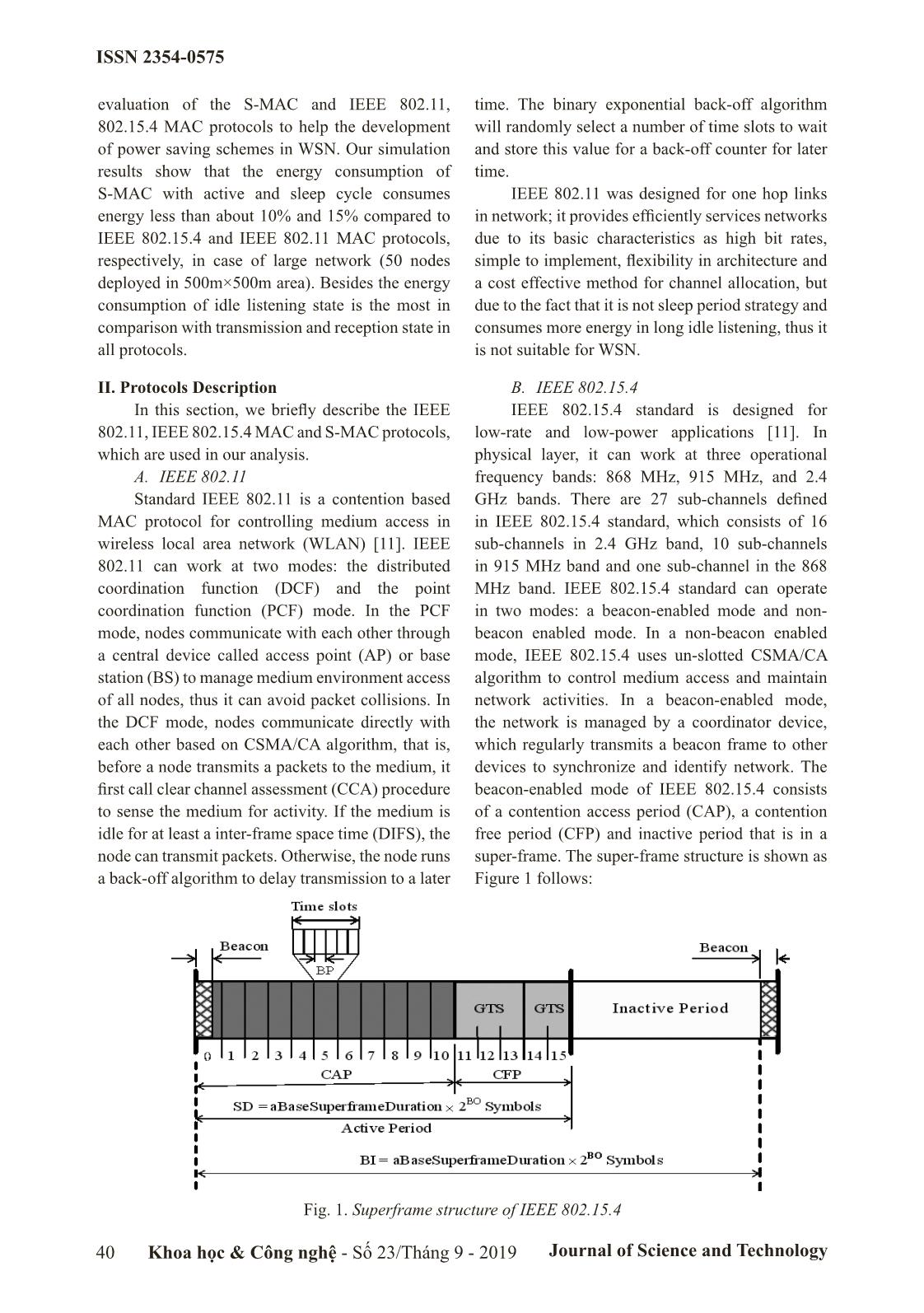
Trang 2
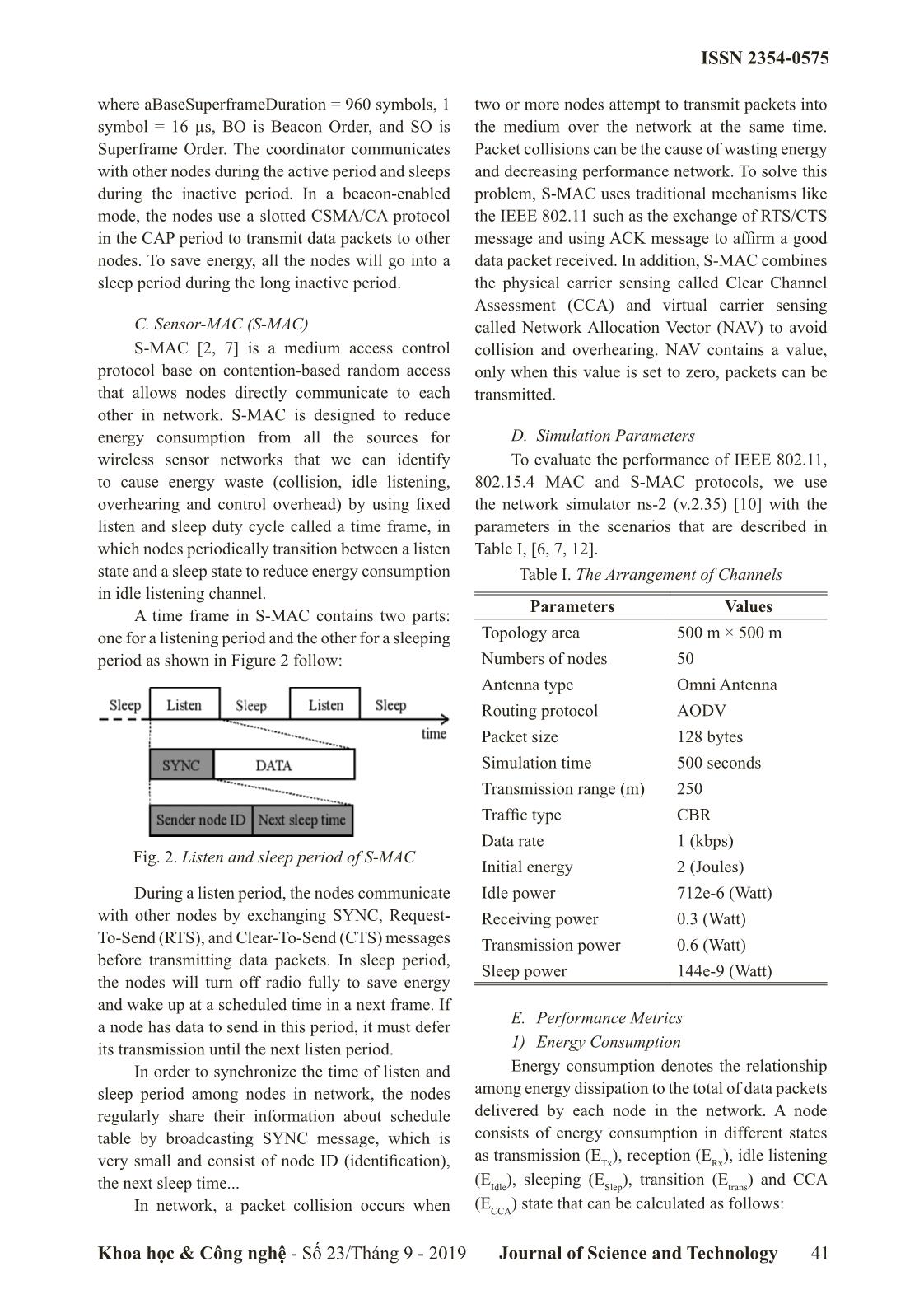
Trang 3

Trang 4

Trang 5
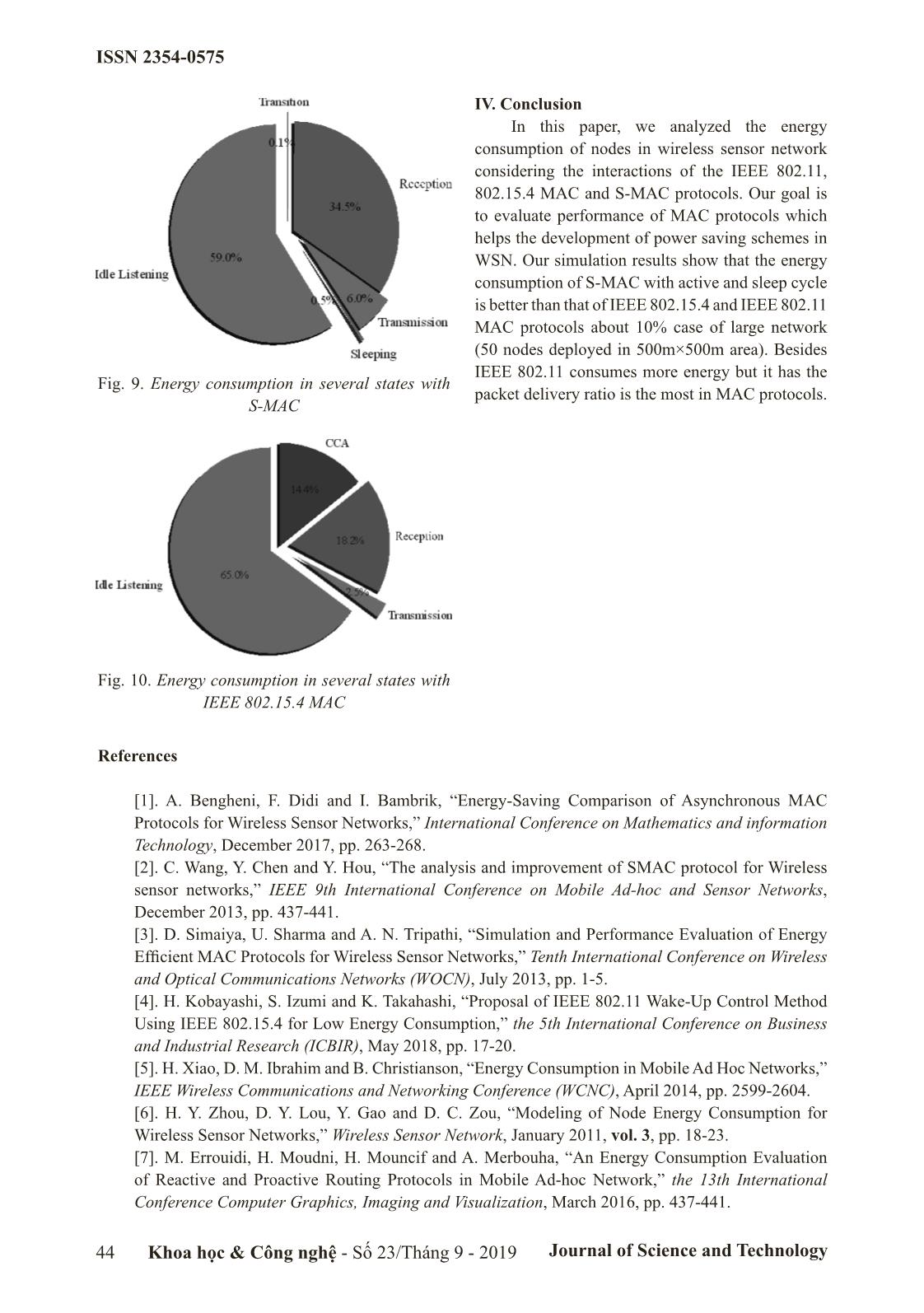
Trang 6
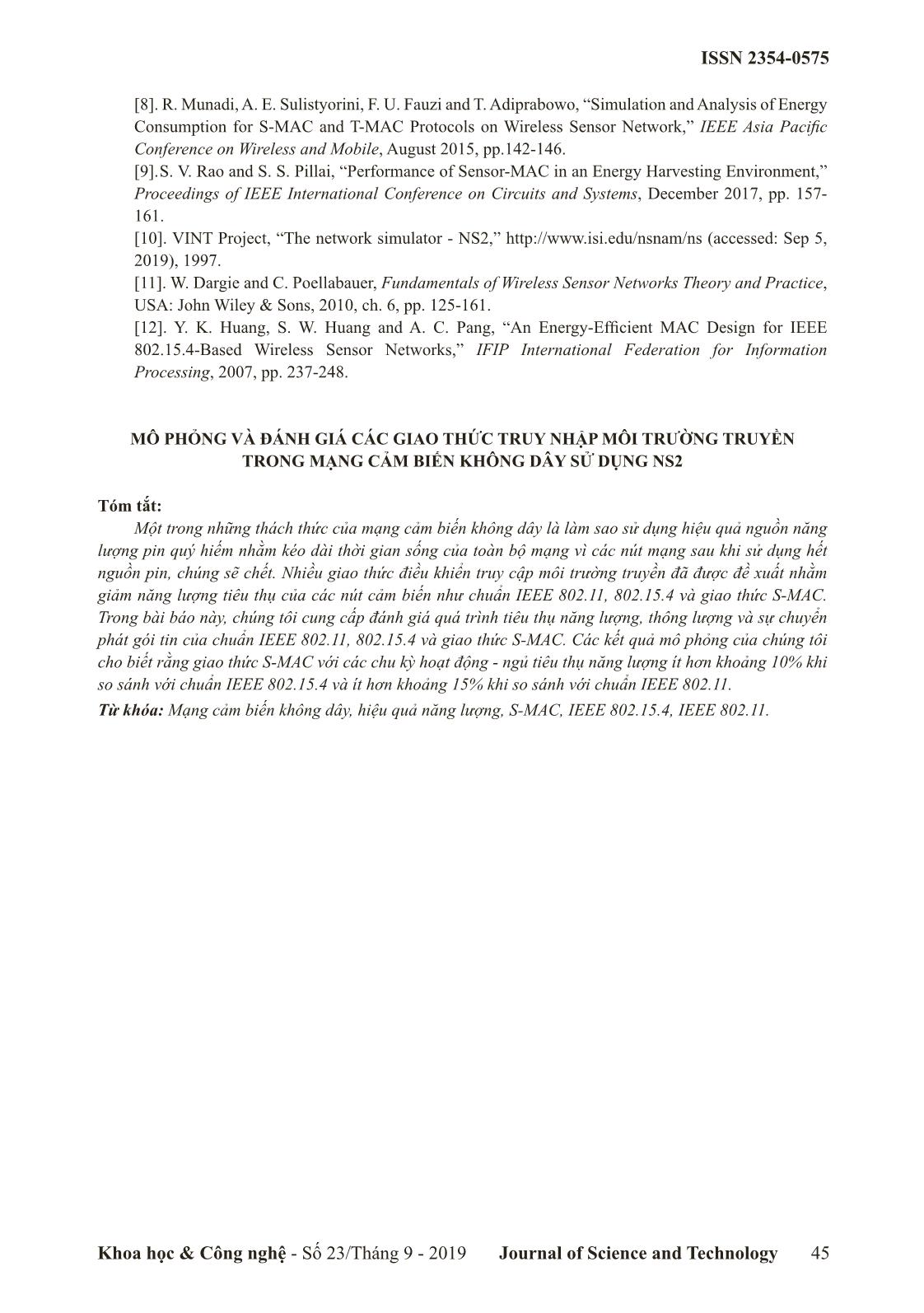
Trang 7
Tóm tắt nội dung tài liệu: Simulation and evaluation about mac protocols in wireless sensor network using NS2
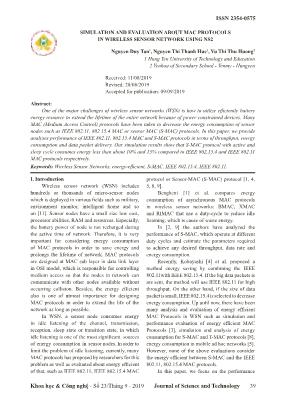
ckets to the medium, it first call clear channel assessment (CCA) procedure to sense the medium for activity. If the medium is idle for at least a inter-frame space time (DIFS), the node can transmit packets. Otherwise, the node runs a back-off algorithm to delay transmission to a later time. The binary exponential back-off algorithm will randomly select a number of time slots to wait and store this value for a back-off counter for later time. IEEE 802.11 was designed for one hop links in network; it provides efficiently services networks due to its basic characteristics as high bit rates, simple to implement, flexibility in architecture and a cost effective method for channel allocation, but due to the fact that it is not sleep period strategy and consumes more energy in long idle listening, thus it is not suitable for WSN. B. IEEE 802.15.4 IEEE 802.15.4 standard is designed for low-rate and low-power applications [11]. In physical layer, it can work at three operational frequency bands: 868 MHz, 915 MHz, and 2.4 GHz bands. There are 27 sub-channels defined in IEEE 802.15.4 standard, which consists of 16 sub-channels in 2.4 GHz band, 10 sub-channels in 915 MHz band and one sub-channel in the 868 MHz band. IEEE 802.15.4 standard can operate in two modes: a beacon-enabled mode and non- beacon enabled mode. In a non-beacon enabled mode, IEEE 802.15.4 uses un-slotted CSMA/CA algorithm to control medium access and maintain network activities. In a beacon-enabled mode, the network is managed by a coordinator device, which regularly transmits a beacon frame to other devices to synchronize and identify network. The beacon-enabled mode of IEEE 802.15.4 consists of a contention access period (CAP), a contention free period (CFP) and inactive period that is in a super-frame. The super-frame structure is shown as Figure 1 follows: Fig. 1. Superframe structure of IEEE 802.15.4 ISSN 2354-0575 Khoa học & Công nghệ - Số 23/Tháng 9 - 2019 Journal of Science and Technology 41 where aBaseSuperframeDuration = 960 symbols, 1 symbol = 16 µs, BO is Beacon Order, and SO is Superframe Order. The coordinator communicates with other nodes during the active period and sleeps during the inactive period. In a beacon-enabled mode, the nodes use a slotted CSMA/CA protocol in the CAP period to transmit data packets to other nodes. To save energy, all the nodes will go into a sleep period during the long inactive period. C. Sensor-MAC (S-MAC) S-MAC [2, 7] is a medium access control protocol base on contention-based random access that allows nodes directly communicate to each other in network. S-MAC is designed to reduce energy consumption from all the sources for wireless sensor networks that we can identify to cause energy waste (collision, idle listening, overhearing and control overhead) by using fixed listen and sleep duty cycle called a time frame, in which nodes periodically transition between a listen state and a sleep state to reduce energy consumption in idle listening channel. A time frame in S-MAC contains two parts: one for a listening period and the other for a sleeping period as shown in Figure 2 follow: Fig. 2. Listen and sleep period of S-MAC During a listen period, the nodes communicate with other nodes by exchanging SYNC, Request- To-Send (RTS), and Clear-To-Send (CTS) messages before transmitting data packets. In sleep period, the nodes will turn off radio fully to save energy and wake up at a scheduled time in a next frame. If a node has data to send in this period, it must defer its transmission until the next listen period. In order to synchronize the time of listen and sleep period among nodes in network, the nodes regularly share their information about schedule table by broadcasting SYNC message, which is very small and consist of node ID (identification), the next sleep time... In network, a packet collision occurs when two or more nodes attempt to transmit packets into the medium over the network at the same time. Packet collisions can be the cause of wasting energy and decreasing performance network. To solve this problem, S-MAC uses traditional mechanisms like the IEEE 802.11 such as the exchange of RTS/CTS message and using ACK message to affirm a good data packet received. In addition, S-MAC combines the physical carrier sensing called Clear Channel Assessment (CCA) and virtual carrier sensing called Network Allocation Vector (NAV) to avoid collision and overhearing. NAV contains a value, only when this value is set to zero, packets can be transmitted. D. Simulation Parameters To evaluate the performance of IEEE 802.11, 802.15.4 MAC and S-MAC protocols, we use the network simulator ns-2 (v.2.35) [10] with the parameters in the scenarios that are described in Table I, [6, 7, 12]. Table I. The Arrangement of Channels Parameters Values Topology area 500 m × 500 m Numbers of nodes 50 Antenna type Omni Antenna Routing protocol AODV Packet size 128 bytes Simulation time 500 seconds Transmission range (m) 250 Traffic type CBR Data rate 1 (kbps) Initial energy 2 (Joules) Idle power 712e-6 (Watt) Receiving power 0.3 (Watt) Transmission power 0.6 (Watt) Sleep power 144e-9 (Watt) E. Performance Metrics 1) Energy Consumption Energy consumption denotes the relationship among energy dissipation to the total of data packets delivered by each node in the network. A node consists of energy consumption in different states as transmission (E Tx ), reception (E Rx ), idle listening (E Idle ), sleeping (ESlep), transition (Etrans) and CCA (E CCA ) state that can be calculated as follows: ISSN 2354-0575 Journal of Science and Technology42 Khoa học & Công nghệ - Số 23/Tháng 9 - 2019 / / ( ) E E E E E E E P Ps R P Ps R P T P T P T k P T node Tx Rx Idle Sleep Trans CCA Tx i i Ntx Rx j j Nrx Idle Idle Sleep Sleep trans trans k N CCA CCA 1 1 1 trans = + + + + + = + + + + + = = = / / / (1) where E x , P x and T x are the energy consumption (joules), the power (watt) and the time interval of transceiver in state x (second). Psi and R are the size of length of the ith packet of receiving or sending and R is the data transferring rate. N tx and N rx are total numbers of receiving or sending packets. ( ) E n E i AN node i n 1= = / (2) where E AN are the average energy consumption of all nodes in network, n is number of nodes in network. 2) Throughput: Throughput express the total count of data packets transported to destination nodes of one flow (connection) in network during the simulation time. The average throughput of the entire network expresses the average throughput of each connection. The average throughput of each connection is calculated by the total size of received packets at destination node per the time, which takes for traffic to flow through the connection. * ( )t t Ps bps 8 Throughput_of_ flow i i m 2 1 1 j = - = / (3) )_ _ _ _ networkThroughput of (Throughput of flow j j 1 k = = / (4) where Psi is the size of length of the i th packet reaching the destination, t 1 and t 2 are the time when first packet sent by source node and the time when last packets received by destination node, respectively. 3) Energy Efficiency: Energy efficiency is defined as the throughput achieved per unit of energy consumed, where the throughput represents the number of successfully delivered packets. _ _ ( ) ( ) Energy efficiency Energy consumption Joules Throughput packets = (5) 4) Packet Delivery Ratio (PDR): PDR represents the ratio of data packets successfully received from all the sent data packets, which is computed as below: PDR Ns Nr= (6) Where Nr and Ns are the number of packets received by destination node and the number of packet sent by source node, respectively. III. Results and Analysis Figure 3 represents the percentage of power consumption of IEEE 802.15.4, 802.11 MAC and S-MAC protocols during simulation time. It is clearly observable that the S-MAC protocol with active and sleep cycle has better performance in reducing energy consumption of nodes than IEEE 802.15.4 and 802.11 MAC protocols. Fig. 3. Energy consumption during the simulation time Fig. 4. Energy consumption per number of flows Figure 4 shows the energy consumption of nodes when we increase the number of connection ISSN 2354-0575 Khoa học & Công nghệ - Số 23/Tháng 9 - 2019 Journal of Science and Technology 43 (flow) in network. It seems that energy consumed increases as the number of nodes sent data packets increases with all MAC protocols, but it is rapid increase about energy consumption with IEEE 802.11 MAC and S-MAC having the lowest consumption of energy. As illustrated in Figure 5 and 6, the average throughput and energy efficiency of protocols is analyzed in increased number of sent nodes. We can see that IEEE 802.11 MAC with the high throughput achieved the better energy efficiency than IEEE 802.15.4 MAC and S-MAC protocols. Fig. 5. The average throughput Fig. 6. Energy efficiency In Figure 7, we illustrate the packet delivery ratio for both three protocols in the number of flows. Based on results shown in Figure 6, we can obviously observe that the packet delivery ratio in the network in the IEEE 802.11 MAC protocol is higher than about 200% compared to IEEE 802.15.4 MAC and S-MAC protocols. Fig. 7. Packet delivery ratio The percentage of energy consumption in different states of all nodes in network are illustrated in Figures 8, 9 and 10 in which idle listening state consumes more energy than other states, it is 87.7%, 59 and 59% with IEEE 802.11, % IEEE 802.15.4 MAC and S-MAC, respectively. The sleeping and transition state consume lowest energy but the total of energy consumption of IEEE 802.11 and 802.15.4 MAC protocols are still more higher than S-MAC because nodes have listened channel to check packets came while S-MAC achieves energy efficiency by switching the radio in sleep and active state periodically, so S-MAC achieves energy savings thereby providing longer lifetime of network. Fig. 8. Energy consumption in several states with IEEE 802.11 MAC ISSN 2354-0575 Journal of Science and Technology44 Khoa học & Công nghệ - Số 23/Tháng 9 - 2019 Fig. 9. Energy consumption in several states with S-MAC Fig. 10. Energy consumption in several states with IEEE 802.15.4 MAC IV. Conclusion In this paper, we analyzed the energy consumption of nodes in wireless sensor network considering the interactions of the IEEE 802.11, 802.15.4 MAC and S-MAC protocols. Our goal is to evaluate performance of MAC protocols which helps the development of power saving schemes in WSN. Our simulation results show that the energy consumption of S-MAC with active and sleep cycle is better than that of IEEE 802.15.4 and IEEE 802.11 MAC protocols about 10% case of large network (50 nodes deployed in 500m×500m area). Besides IEEE 802.11 consumes more energy but it has the packet delivery ratio is the most in MAC protocols. References [1]. A. Bengheni, F. Didi and I. Bambrik, “Energy-Saving Comparison of Asynchronous MAC Protocols for Wireless Sensor Networks,” International Conference on Mathematics and information Technology, December 2017, pp. 263-268. [2]. C. Wang, Y. Chen and Y. Hou, “The analysis and improvement of SMAC protocol for Wireless sensor networks,” IEEE 9th International Conference on Mobile Ad-hoc and Sensor Networks, December 2013, pp. 437-441. [3]. D. Simaiya, U. Sharma and A. N. Tripathi, “Simulation and Performance Evaluation of Energy Efficient MAC Protocols for Wireless Sensor Networks,” Tenth International Conference on Wireless and Optical Communications Networks (WOCN), July 2013, pp. 1-5. [4]. H. Kobayashi, S. Izumi and K. Takahashi, “Proposal of IEEE 802.11 Wake-Up Control Method Using IEEE 802.15.4 for Low Energy Consumption,” the 5th International Conference on Business and Industrial Research (ICBIR), May 2018, pp. 17-20. [5]. H. Xiao, D. M. Ibrahim and B. Christianson, “Energy Consumption in Mobile Ad Hoc Networks,” IEEE Wireless Communications and Networking Conference (WCNC), April 2014, pp. 2599-2604. [6]. H. Y. Zhou, D. Y. Lou, Y. Gao and D. C. Zou, “Modeling of Node Energy Consumption for Wireless Sensor Networks,” Wireless Sensor Network, January 2011, vol. 3, pp. 18-23. [7]. M. Errouidi, H. Moudni, H. Mouncif and A. Merbouha, “An Energy Consumption Evaluation of Reactive and Proactive Routing Protocols in Mobile Ad-hoc Network,” the 13th International Conference Computer Graphics, Imaging and Visualization, March 2016, pp. 437-441. ISSN 2354-0575 Khoa học & Công nghệ - Số 23/Tháng 9 - 2019 Journal of Science and Technology 45 [8]. R. Munadi, A. E. Sulistyorini, F. U. Fauzi and T. Adiprabowo, “Simulation and Analysis of Energy Consumption for S-MAC and T-MAC Protocols on Wireless Sensor Network,” IEEE Asia Pacific Conference on Wireless and Mobile, August 2015, pp.142-146. [9]. S. V. Rao and S. S. Pillai, “Performance of Sensor-MAC in an Energy Harvesting Environment,” Proceedings of IEEE International Conference on Circuits and Systems, December 2017, pp. 157- 161. [10]. VINT Project, “The network simulator - NS2,” (accessed: Sep 5, 2019), 1997. [11]. W. Dargie and C. Poellabauer, Fundamentals of Wireless Sensor Networks Theory and Practice, USA: John Wiley & Sons, 2010, ch. 6, pp. 125-161. [12]. Y. K. Huang, S. W. Huang and A. C. Pang, “An Energy-Efficient MAC Design for IEEE 802.15.4-Based Wireless Sensor Networks,” IFIP International Federation for Information Processing, 2007, pp. 237-248. MÔ PHỎNG VÀ ĐÁNH GIÁ CÁC GIAO THỨC TRUY NHẬP MÔI TRƯỜNG TRUYỀN TRONG MẠNG CẢM BIẾN KHÔNG DÂY SỬ DỤNG NS2 Tóm tắt: Một trong những thách thức của mạng cảm biến không dây là làm sao sử dụng hiệu quả nguồn năng lượng pin quý hiếm nhằm kéo dài thời gian sống của toàn bộ mạng vì các nút mạng sau khi sử dụng hết nguồn pin, chúng sẽ chết. Nhiều giao thức điều khiển truy cập môi trường truyền đã được đề xuất nhằm giảm năng lượng tiêu thụ của các nút cảm biến như chuẩn IEEE 802.11, 802.15.4 và giao thức S-MAC. Trong bài báo này, chúng tôi cung cấp đánh giá quá trình tiêu thụ năng lượng, thông lượng và sự chuyển phát gói tin của chuẩn IEEE 802.11, 802.15.4 và giao thức S-MAC. Các kết quả mô phỏng của chúng tôi cho biết rằng giao thức S-MAC với các chu kỳ hoạt động - ngủ tiêu thụ năng lượng ít hơn khoảng 10% khi so sánh với chuẩn IEEE 802.15.4 và ít hơn khoảng 15% khi so sánh với chuẩn IEEE 802.11. Từ khóa: Mạng cảm biến không dây, hiệu quả năng lượng, S-MAC, IEEE 802.15.4, IEEE 802.11.
File đính kèm:
 simulation_and_evaluation_about_mac_protocols_in_wireless_se.pdf
simulation_and_evaluation_about_mac_protocols_in_wireless_se.pdf

